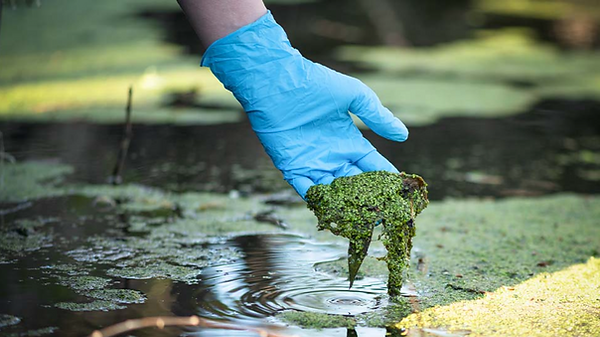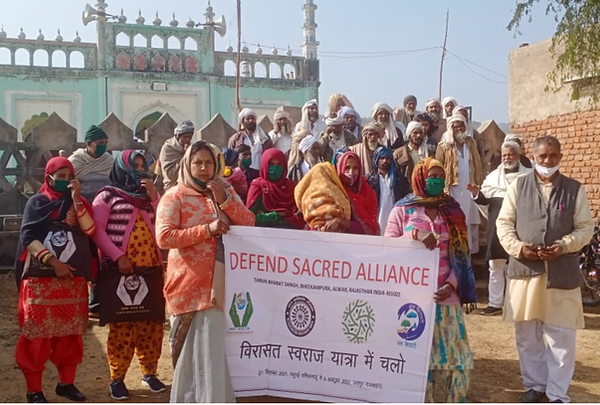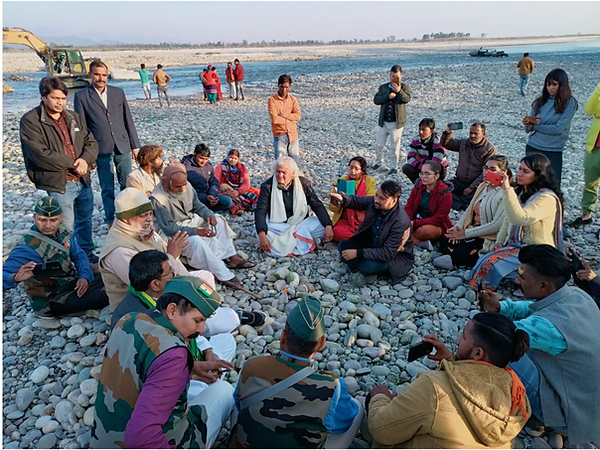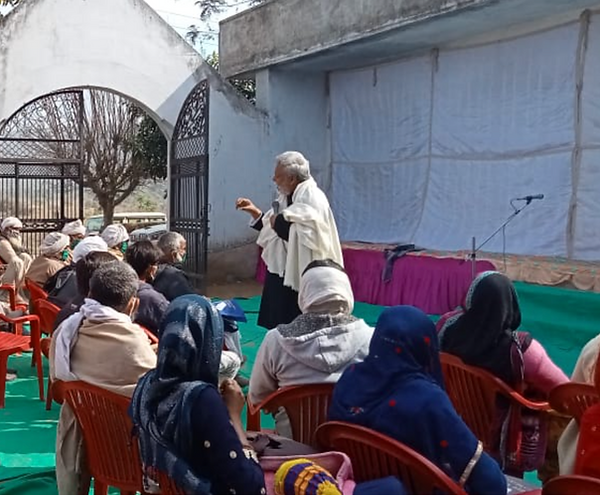
The following reflections stem from debates and webinars organised by the Water Value Research Group, University of Leeds. Its founding members are Joshua Cohen, Charlie Dannreuther, Colin Mackie, Julia Martin Ortega, Anna Mdee, Markus Fraundorfer and Nicolas Salazar Sutil.
Not a concept. Not an idea found in a book.



Algal bloom in the River Wye in the England-Wales border. Like in Lake Eyre and many other places , this phenomenon is largely due to run-off from industrial chicken farming
If places become easily consumed and owned, then it is easy to become visitors that merely go to the river, perform chosen activities, consume, then leave. Why are we not staying?
Perhaps because many of us do not see ourselves as river people. People made of river, for river. Perhaps we fail to see movement connecting humans and rivers within the same interconnected web, call it fate. I have an image in my mind. People and river weaving each other to form a basketwork. The basket of water contains us, and it is so close to life as to make no difference.
Perhaps we do not acknowledge the waters snaking away. Perhaps we ignore water’s cycle, character, personhood. In other words, we do not see a dynamic being.
Riverkin: time to heal vital relations
Beirut River in Lebanon used as a dumping site
Parana River in the Brazil-Argentina border dries up
Citarum River in Indonesia flows full of plastic waste
The question of how communities can reconnect with rivers is perhaps a question of how to mend a broken relationship. To mend, I guess, first you need to heal. If this is not the right time to heal, then when?
Often rivers are blamed for being too polluted, for carrying too much or too little water, for being too wide, too thin, too fast, too slow. Like an old love, we perhaps blame rivers for a failure that ultimately could lay within ourselves.
What is broken is not river, but the understanding, or lack of understanding, that many of us have. For many, the river is a place. It is conceived spatially, perhaps as a body of water running through the land. Something that can be measured, mapped and diagrammed, like the picture of the river cycle in a standard school textbook.
That is not what a river is.
River is not constrained by space. River is always passing. Like time. To me that is the biggest lesson of the river: everything passes. Only riverbeds remain, like the empty side of a bed where a long-gone lover used to lay.
And therein lies the misconception. Generally speaking, modern community life does not often see itself reflected in the passing waters, perhaps only in fragmented reflections.
At school, I did not learn any of this. No-one showed me that the friendly river is holding a mirror reflecting perhaps a better version of myself. We no longer learn to divine waters and see in the aquatic oracle a sign of the future.
The trouble with seeing river as site, is that river becomes easily consumable.
“It” becomes a site for people to use. “It” becomes a dumping or fly-tipping site. “It” becomes a mine. A watermill, a dam or power station. A watersports club, a nature reconnection camp or leisure area. A fishing site. A tourist site. A bankside lined with restaurants and commercial venues.At best, “it” becomes a river school where people teach what they know about rivers, but where rivers are rarely allowed to teach what they know about people.
By fixating on river as physical space, we perhaps focus on a material property of river that can be known and owned, but we do not necessarily see what is passing-- flows and rhythms of time, the healing properties of a regenerative and cyclical life.
What does the river want? What is the river’s will? Regardless of humanity’s need to master "it", where is the river flowing? It is not always the sea.
The sacred Yamuna River, known as the river of love, covered in toxic foam, Delhi.
If we learned to see river as a fellow being fully possessed with life and voice, river rights would be common, as they should be. After all, river lives matter.
The river is so vast an entity, I believe it is best understood collectively. It is only from the perspective of collective rights that we can begin to fathom riverkin.

Finally, what will mend the broken relationship? Love, I would like to think, and the practice of reciprocity.
Kinship is based on this practice, I would argue. Loving others as members of one’s own circle: family, tribe, community— call it what you will. This is a matter of loving river as father, as mother, as child, as life-long partner, as wife and husband, as ancestor. That is riverkin.

Euphrates River, Iraq
I have struggled to convey what this feels like. So much of what I hear in current debates is stuck in the head, not in the heart.
There are many kinds of hearts, I suppose. I am thinking of hearts that follow the pace of deep country, beating in synch with the rhythms of deep rivers. It takes more than a concept in a theory of change to have felt all of that.
Two beings sustain each other and grow through the seasons of change when there is enduring care, respect and responsibility. It is not enough to talk about saving rivers, to post in social media or to attend courses. What should permeate all of this is the feeling of love, embraced by life values. Scrambling for short-term relationships where we should be nurturing kinships. Ancestral and long-term future commitments to river is what I am calling for.
In the end, we are standing on two feet, perhaps so we may wade on water. Webbed fingers on our hands, not least so that we may swim smoothly along. We carry river in our blood-vessels, replicating the way river carries personhood— humanity— in her waters.
I think we should honour, respect, admire, care, give thanks to and venerate river. We should start, I think, by treating other people like this, and then cultivate such relations with rivers not in some pretentious way, but in some modestly spiritual way.

Petorca River in Chile dries up due to water overconsumption by industrial avocado plantations
Wear the ring of time on your finger. River is an honest reminder of a spiritual commitment to the rhythm of dreams and realities, hardships and joys, pains and relief, the celebration and the mourning, of passing life.
Before you take your first steps in the water, at least in the Maya tradition of cenote ritual bathing, you must wash your face, give thanks and pray. Only then can you enter the water fully. You must also ask permission from the lady of the waters, so she may reveal her power to cure. That is because river, like time, heals.
Perhaps what is most lacking here and now is a sense of ancestral relationship with, and future belonging to, river. River is the uterus where we all ultimately formed and where our ashes will be spread. How are we going to find the courage to remember that, if so many people are desperately trying to forget?
Next time you walk into the water you will step back in time to a moment when you and I, human and river, first held each other tight.

Murray-Darling River in Australia runs dry

Guardians of the Ganga to form River Parliament
By Rajendra Singh and Nicolas Salazar Sutil
More than fifty representatives from across India came together on the banks of the River Ganga at Kankhal on December 24th to pursue demands against the construction of a dam and to stop illegal mining in the area. The Ganga River flows through five Indian states, namely Uttarakhand, Uttar Pradesh, Bihar, Jharkhand, and West Bengal. The river’s tributaries and distributaries, which are part of the vast Ganga River Basin, extend to Rajasthan, Haryana, Delhi, Punjab, Madhya Pradesh, and Chhattisgarh. With representatives from every one of these eleven major Indian states, the attendees of the December 24 meeting have pledged to form the "Ganga River Parliament" which will represent and defend the river at local, nationwide, and worldwide level.
The new parliament is presided by Swami Shri Shivanand Ji Maharaj, a well-known spiritual leader associated with the Matri Sadan group. Originating in the late nineties, Matri Sadan is a social, environmental, and spiritual movement inspired by the peaceful and nonviolent resistance and social justice movement led by Mahatma Gandhi in the 1940s. The aim of Matri Sadan is to protect rivers from indiscriminate mining and damning, especially in the Kumbh Mela area of Haridwar.
In June 2011, after a 68-day hunger strike to prevent illegal mining on the Ganga, Swami Nigmanand Ji was poisoned at the Himalayan Institute Hospital. A disciple of Swami Shri, Ningamand has become a symbol of the ongoing violence committed against Indian rivers and its defenders. Swami Nigmanand’s death has become a linchpin in the longstanding fight to guarantee that the Ganga flows unimpeded by dams and free of pollution. Yet his death also exemplifies an unrestored justice in India that is needed at the spiritual, social, and environmental level. There can be no justice without protection of rivers, people and their local beliefs and customs. The Indian government has yet to account for the destruction of India’s national river, which has been declared biologically dead along large sections. Nor has the justice system acknowledged the scores of river guardians and saints who have died to save the Holy River, a phenomenon known locally as the “Ganga killings”.

“Ganga, our national river has now become our national guilt.” Prof. Sanand Ji
River Ganga is one of the world’s great rivers, a site of nationwide and worldwide heritage. It is beyond question one of the most sacred sites in the world, yet it is consistently listed as the world’s most contaminated river. Although severely polluted with human waste and industrial contaminants, Ganga’s waters are consumed by around 40% of India's population, serving an estimated 500 million people, more than any other river in the world. Health risks caused by pollution in the Ganga apply to large human populations as well as numerous endangered animal species (including the iconic Ganges River dolphin) and thousands of native species of plants and trees. Matri Sadan has been calling for the Indian government to guarantee that the area in the vicinity of the river, be it in the Blue Zone, Green Zone or Red Zone, should be declared as “Forest Land” which would further guarantee that the Ganga flows uninterruptedly in its journey to the Bay of Benghal.
The principal aim of the December 24 meeting, according to Swami Shri, is to "know our Holy Mother Ganga". As President of the Ganga River Parliament, Swami Shri argues that it is vital for people to understand rivers as mothers. “Only then” he maintains, “are we able to take better care of Maa Ganga’s health and serve her with complete devotion.” The underlying commitment of the Ganga River Parliament, according to Swami Shri, is to halt construction of dams and illegal mining, pursue local government to enact abiding laws that can protect, preserve, and conserve the Holy River, while safeguarding vegetation cover throughout the river basin and improving biodiversity.
Ganga River Parliament has brought together concerned citizens, government officials, civil society, and Matri Sadan saints. One of the key arguments made by the new parliament is that the crisis is not only social or environmental, but also spiritual. Spiritual values are therefore necessary to galvanise change at the personal level through a rejection of the for-profit and extractivist mindsets that has led to rampant pollution and destruction of the river. Through spiritual knowledge, the Ganga River Parliament seeks to find real-world solutions to ecological and social degradation, whilst campaigning for environmental, social, and ultimately, political change.
The five demands of the Ganga River Guardians and River Parliament are:
1. To persuade and pressurize the Indian government to ban mining completely in the Kumbh Kshetra in Haridwar.
2. To ensure the immediate enactment of legal orders for the protection of the river by word and spirit on the ground.
3. To ensure that the “Ganga Preservation and Management Draft Bill” put forth by Ganga River guardian and martyr Sanand Ji, is duly presented, discussed, and passed in Parliament.
4. To ensure that no new dams are constructed on River Ganga in the Himalayas and elsewhere.
5. To generate awareness pertaining to the distinct qualities of the water of river Ganga, and in the process ensure that Government, Civil Society and local Saints come together to raise consciousness among the national and international community.
The Ganga River Parliament will provide equal opportunities for new members seeking to join, so long as the motives of prospective members is not driven by self-interest, but by the collective effort to strengthen and amplify the work of the various parliamentary committees.
To further support and expand this alliance, the Ganga River Parliament has joined Guardians Worldwide, an organisation based in London that facilitates capacity building, knowledge exchange and technical support for nature guardians around the world.
The aim of this international partnership is to connect the Ganga River Parliament with members of Guardians of the River, a Massive Online Open Course (MOOC) on river protection led by renowned water environmentalists from all around the world. The course, which starts February 2, 2022, will be delivered online and it is open to participants from all around the world who can join via paid registration, or else for free, via a bursary scheme. This collaboration will enable individuals from all around the world to co-design strategies to support, raise funds, and amplify the voice of the Ganga River Parliament.
Guardians of the River, which is curated by Guardians Worldwide and Advaya Initiative, will bring together campaign groups currently protecting rivers all around the globe, including the Atrato in Colombia—which was declared a legal subject under the Rights of Nature in 2018— the Kruščica River in Albania, known as the last wild river of Europe, Lake Turkana in Kenya, São Francisco River in Brazil, Fitzroy River in Australia, and Beirut River in Lebanon, among others.





Global alliances such as this reflect the cross-boundary nature of rivers. Water connects life throughout the globe in extraordinary networks of rivers, ocean currents, and airflows. In much the same way, human connectivity and human-river reciprocity needs to happen across borders, via international alliances and networks that can defend nature globally in times of planetary crisis.
Mother Ganga plays a vital role in the continuity of past, present, and future life. A symbol of life-giving nature, Ganga is holy not only for the millions of local people who live by the side of this river. Mother Ganga is sacred to humanity as a whole, like the Kaaba in Mecca or the Church of the Holy Sepulchre in Jerusalem. Ganga is a world symbol of the unbreakable relationship between humans and rivers. She represents the transubstantiation of water into blood. To destroy that relationship is like cutting our bond with life itself.

Guardians Worldwide is an international non-profit organisation. We are registered as:
Associaçao Guardians Worldwide, Portugal (NIPC: 518596737)
GWW Africa Ltd, Nigeria (Reg No: 8272797)
Guardians UK (Charity Commission of England and Wales, Charity Number 1214169)
Guardians Worldwide
Reserva Florestal Portelas
Caminho das Portelas Predio 394
Penamacor
6080-901
Portugal
Mission


